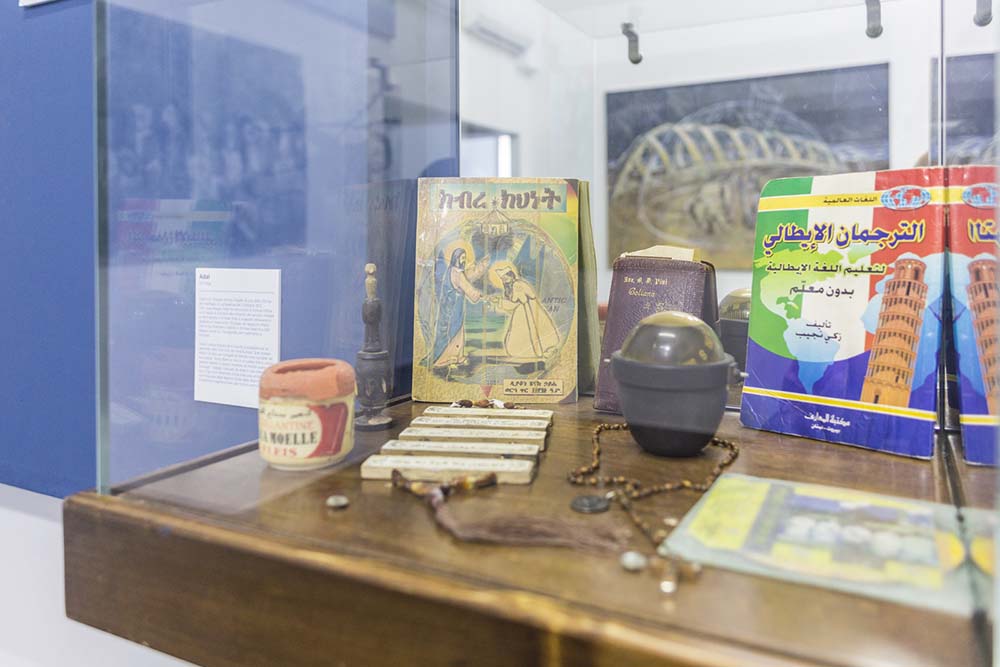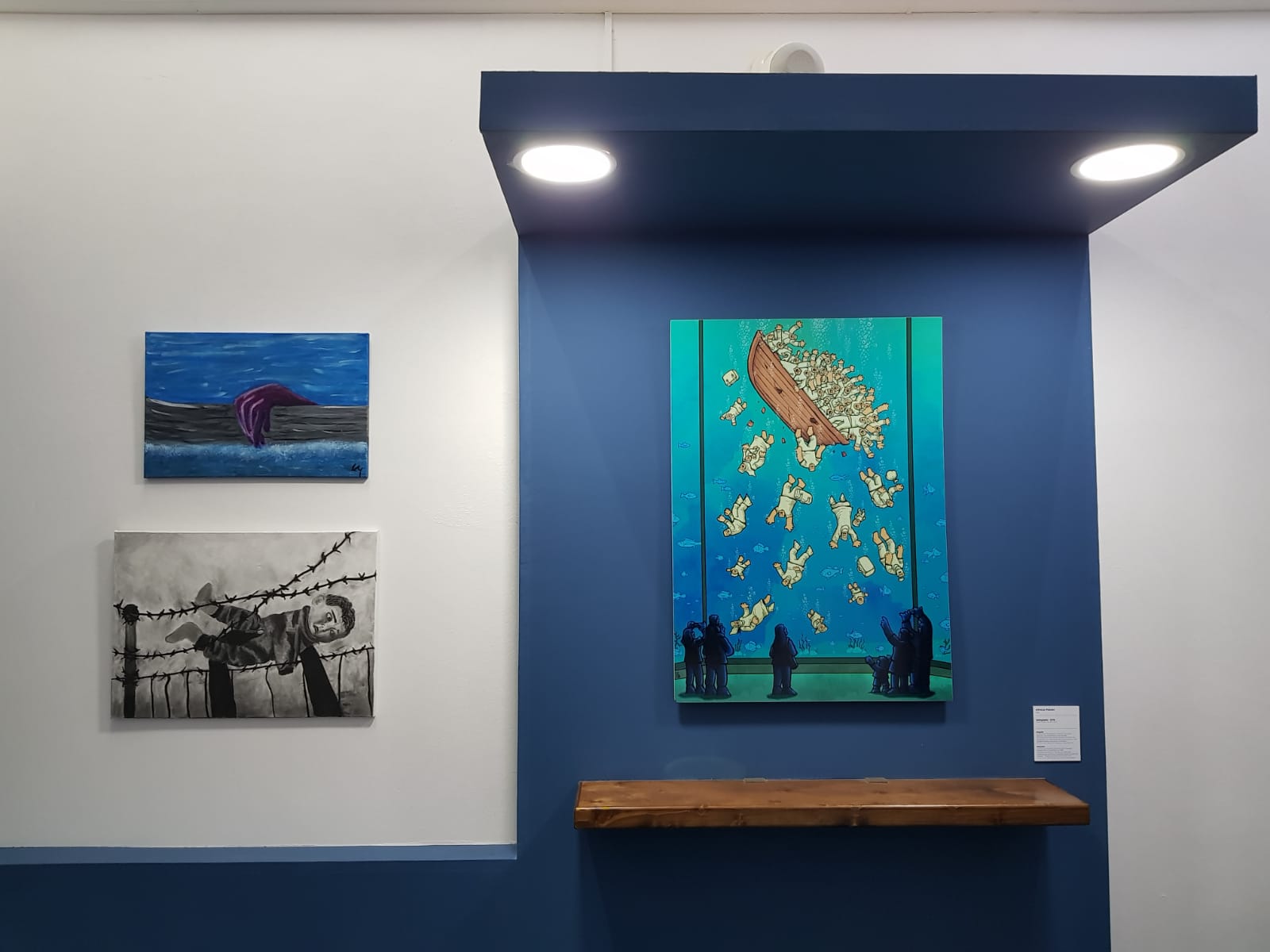A small museum, troubled both in history and content, has crossed the walls of the island of Lampedusa for a short time, just a Summer in 2016, but it was able to leave a trace of strong emotional impact. This is the “Museum of Trust and Dialogue for the Mediterranean”, inaugurated by Italian President Sergio Mattarella in June 2016 in Lampedusa, inside the Archaeological Museum of the Pelagie, which opened its doors on the same day. A sign of great symbolic, social and geopolitical value because it represents the desire not to forget the thousands of existences that have touched and still touched the small Sicilian island, placed in the heart of the Mediterranean, which, with its 6 thousand inhabitants, has been in the forefront for landings of migrants arriving from the sea.
The “Museum of Trust and Dialogue for the Mediterranean” in Lampedusa. (Source: Comitato Tre Ottobre)
The project, born from the Municipalities of Lampedusa and Linosa and from the Comitato Tre Ottobre, in collaboration with the Ministry of Cultural Heritage, the Sicilian Region, the Superintendency of Agrigento, the Ministry of Culture of Tunisia, the National Institute of Heritage of Tunisia and with the Italian Cultural Institute of Tunis, took the form of a temporary exhibition, open to the public only from June 3 to October 3 2016, date of the dramatic shipwreck of the island of Rabbits, off the coast of Lampedusa, where 368 migrants died and that was symbolically elected the Day of Memory and Hospitality. A project to which the main ‘giants’ of culture and art, such as the Uffizi, the MUCEM of Marseille, the Correr Museum in Venice, the Bardo Museum in Tunis, the Getty Museum of Malibu and others, and that had been an incredible success with the public, being visited in just four months by over 10,000 people.
[one_half_last]  [/one_half_last]
[/one_half_last]
Now, after a period of rethinking, the “Museum of Trust and the Dialogue for the Mediterranean” has reopened its doors with a novelty. Thanks to a protocol signed last year, on 3 October 2017, by MIUR, Comitato Tre Ottobre and the Municipalities of Lampedusa and Linosa, from August 2018, the Museum, as well as a rich exhibition of photographs, paintings, texts and other objects recovered at sea and belonging to migrants, it also hosts the “room of the shipwreck” which offers visitors a new multimedia itinerary with a strong emotional impact, in which visitors can try to experience first hand the experience of crossing the sea.
The drawings of Adal telling the torture of the Eritrean regime. (Source: Comitato Tre Ottobre)
The section dedicated to young people and Alireza Pakdel artistic works. (Source: Comitato Tre Ottobre)
It can be reached after an ideal journey through the lives of migrants, with showcases in which the objects of daily life, recovered by rescuers in the boats at the bottom of the sea, or in the many half-sunk dinghies, have been assembled. Objects that the 34,000 deaths in the Mediterranean in the crossing from Africa to Europe, had brought with them as an extreme memory of their personal history: a photograph, a rosary, a guide of Italy in Arabic. Stories of people before than statistics and numbers, without face and soul. Through dark corridors, you reach the “room of shipwrecks”, set up with life jackets on the walls. Before entering, one is warned about the hardness of the images that will be projected. An optical illusion brings the visitor into the sea, an inverted sky-earth effect against the background of the “Door of Life” by Mimmo Paladino, emblem of what Lampedusa has represented for so many years for those who went to sea: the first landing of a hope, of a promised land where to rebuild a new life. Through the images and sounds of the video produced by Michele Cirillo for the Comitato Tre Ottobre created thanks to the materials provided by the Coast Guard, by the Fire Brigade and by MSF (Doctors without Borders), the visitor will experience the dramatic sensations of a shipwreck, having the impression of be present at the event. In this setting, the stories of migrants intersect with those of Italian emigrants and displaced people told through the findings provided by the National Civil War Victims Association, in an attempt to destroy physical and mental barriers and cultivate humanity, empathy and solidarity.
The “Room of shipwrecks”. (Source: Comitato Tre Ottobre)
The Comitato Tre Ottobre was born following the shipwreck of 3 October 2013 with the aim of making this date known as “Memorial and Welcome Day” at national and European level. Today, it carries out awareness and advocacy activities to facilitate the opening of humanitarian corridors and legal and safe entry systems, guarantee the respect of the fundamental rights of migrants and refugees, strengthen research and rescue at sea, create a European DNA database for the recognition of victims, promoting the inclusion of migrants in the receiving communities. Every year on this symbolic date, the Committee meet at the island to remember the victims, reflect on the avoidable massacres that are consumed in the Mediterranean Sea and promote awareness and information initiatives. From 2016, on 3rd October the “Day of Memory and Hospitality” is officially celebrated, a national day in memory of the victims of immigration, established by law n. 45/2016.
References
https://www.lampedusapelagie.it/museo-di-lampedusa/
https://www.youtube.com/watch?v=oQySZkCfNmk
https://www.youtube.com/watch?v=l8xSa7bpF4U
Head Image: The “Door of Life” by Mimmo Paladino, Lampedusa. (Source: Comitato Tre Ottobre)
Il Museo della Fiducia e del Dialogo per il Mediterraneo a Lampedusa
Un piccolo museo, dalla storia e dal contenuto travagliato, ha solcato le mura dell’isola di Lampedusa per il tempo breve di un’estate, quella del 2016, lasciando però una traccia di forte impatto emotivo. Si tratta del Museo della Fiducia e del Dialogo per il Mediterraneo, inaugurato dal Presidente italiano Sergio Mattarella nel giugno 2016 a Lampedusa, all’interno del Museo Archeologico delle Pelagie, che apriva le sue porte nello stesso giorno. Un segno dal grande valore simbolico, sociale e geopolitico perché rappresenta la volontà di non dimenticare le migliaia di esistenze che hanno toccato e toccano la piccola isola siciliana nel cuore del Mediterraneo che, con i suoi 6.000 abitanti, è da anni in prima linea per gli sbarchi dei migranti che arrivano dal mare.
Il Museo della Fiducia e del Dialogo per il Mediterraneo a Lampedusa. (Fonte: Comitato Tre Ottobre)
Il progetto, nato dal Comune di Lampedusa e Linosa e dal Comitato Tre Ottobre, in collaborazione con il Ministero dei Beni Culturali, la Regione Siciliana, la Soprintendenza di Agrigento, il Ministero della Cultura della Tunisia, l’Istituto Nazionale del Patrimonio della Tunisia e con l’Istituto Italiano di Cultura di Tunisi, aveva preso la forma di una mostra temporanea, aperta al pubblico solo dal 3 giugno al 3 ottobre del 2016, data del drammatico naufragio dell’isola dei Conigli, a largo di Lampedusa, in cui morirono 368 migranti, che è stata simbolicamente eletta la Giornata della Memoria e dell’Accoglienza. Un progetto cui avevano voluto aderire, attraverso i prestiti di opere, i principali ‘giganti’ della cultura e dell’arte come gli Uffizi, il Mucem di Marsiglia, il Museo Correr di Venezia, il Museo del Bardo di Tunisi, il Getty Museum di Malibù e altri, e che aveva riscosso un incredibile successo di pubblico, venendo visitato in soli quattro mesi da oltre 10.000 persone.
Alcuni allestimenti negli spazi espositivi del museo. (Fonte: Comitato Tre Ottobre)
Ora, dopo un periodo di ripensamento, il Museo della Fiducia e del Dialogo per il Mediterraneo ha riaperto i battenti con una novità. Grazie ad un protocollo firmato lo scorso anno, il 3 ottobre 2017, da MIUR, Comitato Tre Ottobre e comuni di Lampedusa e Linosa, dall’agosto del 2018, il Museo, oltre ad una ricca esposizione di fotografie, dipinti, testi e altri oggetti recuperati in mare e appartenenti ai migranti, ospita anche la “stanza del naufragio” che propone ai visitatori un nuovo itinerario multimediale dal forte impatto emotivo, nel quale i visitatori possono provare a vivere in prima persona l’esperienza della traversata in mare.
I disegni di Adal che raccontano le torture del regime eritreo. (Fonte: Comitato Tre Ottobre)
La sezione dedicata ai giovani e le opere dell’artista Alireza Pakdel. (Fonte: Comitato Tre Ottobre)
Vi si arriva dopo un percorso ideale attraverso le vite dei migranti, con teche in cui sono stati assemblati gli oggetti di vita quotidiana che sono stati recuperati dai soccorritori nei barconi in fondo al mare, o nei tanti gommoni mezzo affondati. Oggetti che i 34.000 morti nel Mediterraneo nella traversata dall’Africa all’Europa, avevano portato con loro come estrema memoria della loro storia personale: una fotografia, un rosario, una guida d’Italia in arabo. Storie di persone prima che statistiche e numeri senza volto e senza anima. Attraverso corridoi scuri, si raggiunge la “stanza dei naufragi”, allestita con giubbotti di salvataggio alle pareti. Prima di entrare, si viene avvertiti sulla durezza delle immagini che verranno proiettate. Un’illusione ottica porta il visitatore in mare, un effetto cielo-terra invertito sullo sfondo della Porta della Vita di Mimmo Paladino, emblema di quello che Lampedusa ha rappresentato per tanti anni per chi si è messo in mare: il primo approdo di una speranza, di una terra promessa dove ricostruire una nuova vita. Attraverso le immagini e i suoni del video realizzato da Michele Cirillo per il Comitato Tre Ottobre – creato grazie ai materiali forniti dalla Guardia costiera, dai Vigili del fuoco e da Medici Senza Frontiere – il visitatore proverà le drammatiche sensazioni di un naufragio, avendo l’impressione di essere presente sul luogo dell’evento. In questo allestimento, le storie dei migranti si intersecano con quelle degli emigrati e sfollati italiani raccontati attraverso i reperti forniti dall’Associazione Nazionale Vittime Civili di Guerra, nel tentativo di distruggere le barriere fisiche e mentali e coltivare umanità, empatia e solidarietà.
La Sala dei Naufragi. (Fonte: Comitato Tre Ottobre)
Il Comitato Tre Ottobre è nato in seguito al naufragio del 3 ottobre 2013 con l’obiettivo di far riconoscere tale data quale “Giornata della Memoria e dell’Accoglienza” a livello nazionale ed europeo. Oggi, porta avanti attività di sensibilizzazione e advocacy per favorire l’apertura di corridoi umanitari e sistemi di ingresso legali e sicuri, garantire l’accoglienza e il rispetto dei diritti fondamentali di migranti e rifugiati, potenziare la ricerca e il soccorso in mare, creare una banca dati europea del DNA per il riconoscimento delle vittime, favorire l’inclusione dei migranti nelle comunità di arrivo. Ogni anno in questa data simbolica il Comitato si ritrova sull’isola per ricordare le vittime, riflettere sulle stragi evitabili che si consumano nel Mar Mediterraneo e promuovere iniziative di sensibilizzazione e informazione. Dal 2016, il 3 ottobre si celebra ufficialmente la “Giornata della Memoria e dell’Accoglienza”, giornata nazionale in memoria delle vittime dell’immigrazione, istituita con la legge n. 45/2016.
Riferimenti
Head Image: La Porta della Vita di Mimmo Paladino, Lampedusa. (Fonte: Comitato Tre Ottobre)




